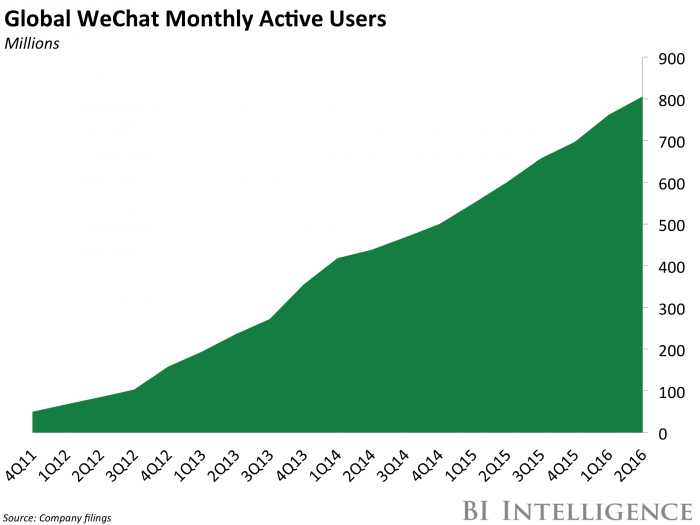WeChat is testing 'lite' app experiences (FB, GOOGL)
This story was delivered to BI Intelligence Apps and Platforms Briefing subscribers. To learn more and subscribe, please click here.

BI IntelligenceWeChat, the most widely used chat app in China, is reportedly testing a new feature that lets users access mobile services and apps without needing to download individual apps, according to South China Morning Post. Dubbed Xiaochengxu, or “Little Program,” the feature enables users to access specific services provided by apps, by either searching for the feature or scanning a QR code. Little Program will strengthen the chat app’s position as the main point of online access for smartphones in China. WeChat supports a slew of services for users beyond that of basic chat, including online shopping, P2P payments, and B2C communications.
The vast majority of WeChat's more than 800 million active users reside in China. WeChat’s dominance in the country means that the addition of Little Program will benefit a number of interested parties:
Startups can use the service as an inexpensive launching platform. WeChat is so prevalent in China that many businesses build a WeChat profile before they build a website or app, according to chatbot authority Michael Yuan. A lightweight option could make it easier for businesses to get in front of consumers quickly while they build out other services, like a fully fledged app or website.
It could provide Android users with an alternative app downloading platform. Google pulled its app store from China in 2014. Since then, the vast majority of Android apps have been downloaded from third-party app stores.
If Little Program gains significant traction, it may threaten the business of major app distributors like the iOS App Store. Apple is actively striving to build out its presence in China — the largest iOS app market in the world. However, WeChat has essentially saturated the market in Tier 1 and Tier 2 cities in China. By offering users a way to get the same experiences without the need to download separate apps, it’s possible that users will be less inclined to download apps from app distributors. Still, WeChat insists that taking business away from app stores is not its play. Rather, the company aims to “provide an open platform for top-quality services.”
Western chat apps, particularly Facebook Messenger, will be taking notes on how this feature will impact the market. WeChat’s innovative approach to messaging has acted as a guide for how many of these apps have evolved, including Messenger and Kik. Providing “lite,” single-service in-app experiences is in line with the vision these chat apps have been chasing.
The top four messaging apps — Facebook's Messenger, WhatsApp, WeChat, and Viber — now claim nearly 3 billion monthly active users combined, narrowly outnumbering the combined active users on the world's four largest social networks, including Facebook.
These numbers have caught the attention of a wide range of businesses, publishers among them. News industry leaders including the Wall Street Journal, The Economist, and the BBC are establishing a presence on a number of chat apps in an effort to be out front and build an audience on the latest platforms where people are consuming content. These early adopters are experimenting to learn which chat apps work for their audience and how they can leverage chat for the distribution of digital content, including articles, images, surveys, and video.
BI Intelligence, Business Insider's premium research service, has compiled a detailed report on messaging apps for publishers that looks at the appeal of these apps and how they're becoming a dominant platform for media consumption. It compares the leading chat platforms, including WhatsApp, WeChat, Facebook's Messenger, and Viber, and what features publishers should know about when thinking about how they might leverage these properties. It also looks at strategies for content distribution across chat apps and finally spotlights some of the challenges that publishers may encounter as they begin to dip their toes into content distribution via messaging apps.
Here are some of the key takeaways:
There are dozens of messaging platforms, each with distinct user demographics and features, and these differences will determine which apps a publisher should try and what type of content is most fitting.
Publishers like The Wall Street Journal, The Economist, and the BBC are experimenting to learn which chat apps work for their audience and how they can leverage chat for the distribution of digital content, including articles, images, surveys, and video.
Chat apps are especially appealing to publishers because they allow these brands to tap into users' "dark social" activity. Dark social traffic stems from people sharing content privately through IM programs, messaging apps, and email, among other means.
Because chat apps were once primarily used for peer-to-peer communications, publishers have an opportunity to reach audiences on these platforms through a more conversational exchange.
In full, the report:
Breaks down the pros and cons of each major messaging app.
Explains the different ways publishers can distribute content on messaging apps.
Highlights the differences between native and linked content.
Looks at the potential barriers that could limit chat apps' utility for publishers.
Interested in getting the full report? Here are two ways to access it:
Subscribe to an All-Access pass to BI Intelligence and gain immediate access to this report and over 100 other expertly researched reports. As an added bonus, you'll also gain access to all future reports and daily newsletters to ensure you stay ahead of the curve and benefit personally and professionally. >> START A MEMBERSHIP
Purchase & download the full report from our research store. >> BUY THE REPORT
See Also:

 Yahoo News
Yahoo News 

